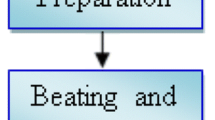Abstract
The quality of ginger rhizomes packaged in low density polyethylene bags (modified atmosphere packaging — MAP) without perforations (P-0), with 2 perforations (P-2), and 12 perforations (P-12) have been investigated for 5 months at 12±1°C. Sprouting and rotting rates of ginger in P-2 and P-12 were lower than ginger in P-0. Weight loss was higher in P-12 than P-0 and P-2. Surface L* (lightness) and a* (redness) values in P-2 and P-12 were lower and higher, respectively, than those found for P-0. Sensory appearance and overall acceptability were rated significantly better in P-2 and P-12 than in P-0. Internal color, firmness, soluble solids, and pH of ginger in MAP were not affected by presence of perforations. Therefore, MAP with the appropriate number of perforations (in this work, 2 perforations) could be a useful method to control sprouting and maintain quality except for surface color of stored ginger rhizomes.
Similar content being viewed by others
References
Jeong MC, Lee SE, Nahmgung B, Chung TY, Kim DC. Changes of quality in ginger according to storage conditions. Korean J. Postharv. Sci. Technol. 5: 224–230 (1998)
Yang WK, Jung CS, Jung KW, Kim JW, Lee EB. Antigastritic and antiulcerative action of the extract of Zingiberis rhizoma. J. Pharm. Soc. Korea 36: 173–179 (1992)
Masuda T, Jitoe A. Antioxidative and antiinflammatory compounds from tropical gingers: Isolation, structure determination, and activities of cassumunins A, B, and C, new complex curcuminoids from Zingiber cassumunar. J. Agr. Food Chem. 42: 1850–1856 (1994)
Sheo HJ. The antibacterial action of garlic, onion, ginger, and red pepper juice. J. Korean Soc. Food Sci. Nutr. 28: 94–99 (1999)
Ryu HS, Kim HS. Effect of Zingiber officinale extracts on mice immune cell activation. Korean J. Nutr. 37: 23–30 (2004)
Fujisawa F, Nadamoto T, Fushiki T. Effect of intake of ginger on peripheral body temperature. J. Jpn. Soc. Nutr. Food Sci. 58: 3–9 (2005)
Mukherjee PK, Thomas P, Raghu K. Shelf-life enhancement of fresh ginger rhizomes at ambient temperatures by combination of γ- irradiation, biocontrol, and closed polyethylene bag storage. Ann. Appl. Biol. 127: 375–384 (1995)
Paull RE, Chen NJ, Goo TTC. Control of weight loss and sprouting of rhizome in storage. Hortic. Sci. 23: 734–736 (1988)
Okwuowulu EOPA, Nnodu EC. Some effects of pre-storage chemical treatments and age at harvesting on the storability of fresh ginger rhizomes. Trop. Sci. 28: 123–125 (1988)
Yusof N. Sprout inhibition by γ-irradiation in fresh ginger. J. Food Process. Pres. 14: 113–122 (1990)
Andrews LS. Chemical and microbial quality of irradiated ground ginger. J. Food Sci. 60: 829–832 (1995)
Chung TY, Lee SE, Jeong MC, Kim DC. Studies on the pretreatment effect of ginger on long-term storage. Korean J. Food Sci. Technol. 28: 458–463 (1996)
Jeong MC, Nahmgung B, Kim DM. Effects of film thickness and moisture absorbing material on ginger quality during MA storage. Korean J. Postharv. Sci. Technol. 6: 264–269 (1999)
Lee DS, Renault P. Using pinholes as tools to attain optimum modified atmospheres in packages of fresh produce. Packag. Technol. Sci. 11: 119–130 (1998)
Kader AA, Zagory D, Kerbel EL. Modified atmosphere packaging of fruits and vegetables. Crit. Rev. Food Sci. 28: 1–30 (1989)
Pesis E, Aharoni D, Aharon Z, Ben-Arie R, Aharoni N, Fuchs Y. Modified atmosphere and modified humidity packaging alleviates chilling injury symptoms in mango fruit. Postharv. Biol. Tec. 19: 93–101 (2000)
Rennie TJ, Tavoularis S. Perforation-mediated modified atmosphere packaging. Part I. Development of a mathematical model. Postharv. Biol. Tec. 51: 1–9 (2009)
Wang CY, Qi L. Modified atmosphere packaging alleviates chilling injury in cucumbers. Postharv. Biol. Tec. 10: 195–200 (1997)
Martinez-Romero D, Guillen F, Castillo S, Valero D, Serrano M. Modified atmosphere packaging maintains quality of table grapes. J. Food Sci. 68: 1838–1843 (2003)
Jia CG, Xu CJ, Wei J, Yuan J, Yuan GF, Wang BL, Wang QM. Effect of modified atmosphere packaging on visual quality and glucosinolates of broccoli florets. Food Chem. 114: 28–37 (2009)
Chung HS, Lee HJ, Moon KD. Effects of ethylene absorbent on quality changes of fresh ginger rhizomes during modified atmosphere storage. Korean J. Hort. Sci. Technol. 28: 82–88 (2010)
Wills RBH, Warton MA, Kim JK. Effect of low levels of ethylene on sprouting of potatoes in storage. Hortic. Sci. 39: 136–137 (2004)
Del-Valle V, Almenar E, Hernandez-Munoz P, Lagaron JM, Catala R, Gavara R. Volatile organic compound permeation through porous polymeric films for modified atmosphere packaging of foods. J. Sci. Food Agr. 84: 937–942 (2004)
Mahajan PV, Rodrigues FAS, Leflaive E. Analysis of water vapor transmission rate of perforation-mediated modified atmosphere packaging (PM-MAP). Biosyst. Eng. 100: 555–561 (2008)
Nielsen T, Leufven A. The effect of modified atmosphere packaging on the quality of Honeoye and Korona strawberries. Food Chem. 107: 1053–1063 (2008)
Kahyaoglu T, Kaya S. Modeling of moisture, color, and texture changes in sesame seeds during the conventional roasting. J. Food Eng. 75: 167–177 (2006)
Shen Q, Kong F, Wang Q. Effect of modified atmosphere packaging on the browning and lignifications of bamboo shoots. J. Food Eng. 77: 348–354 (2006)
Author information
Authors and Affiliations
Corresponding author
Rights and permissions
About this article
Cite this article
Chung, HS., Moon, KD. Sprouting and quality control of fresh ginger rhizomes by modified atmosphere packaging with film perforation. Food Sci Biotechnol 20, 621–627 (2011). https://doi.org/10.1007/s10068-011-0088-4
Received:
Revised:
Accepted:
Published:
Issue Date:
DOI: https://doi.org/10.1007/s10068-011-0088-4




